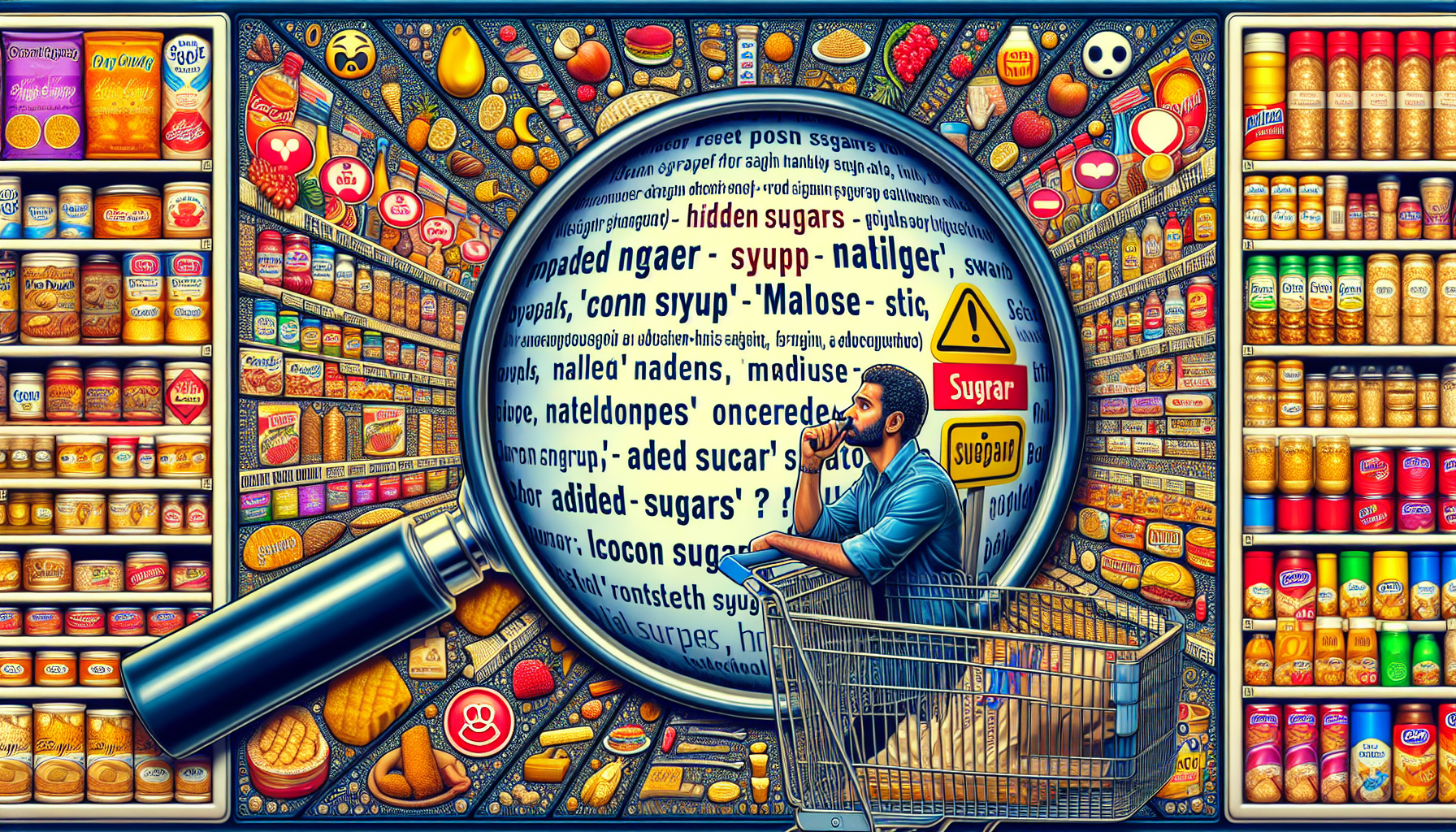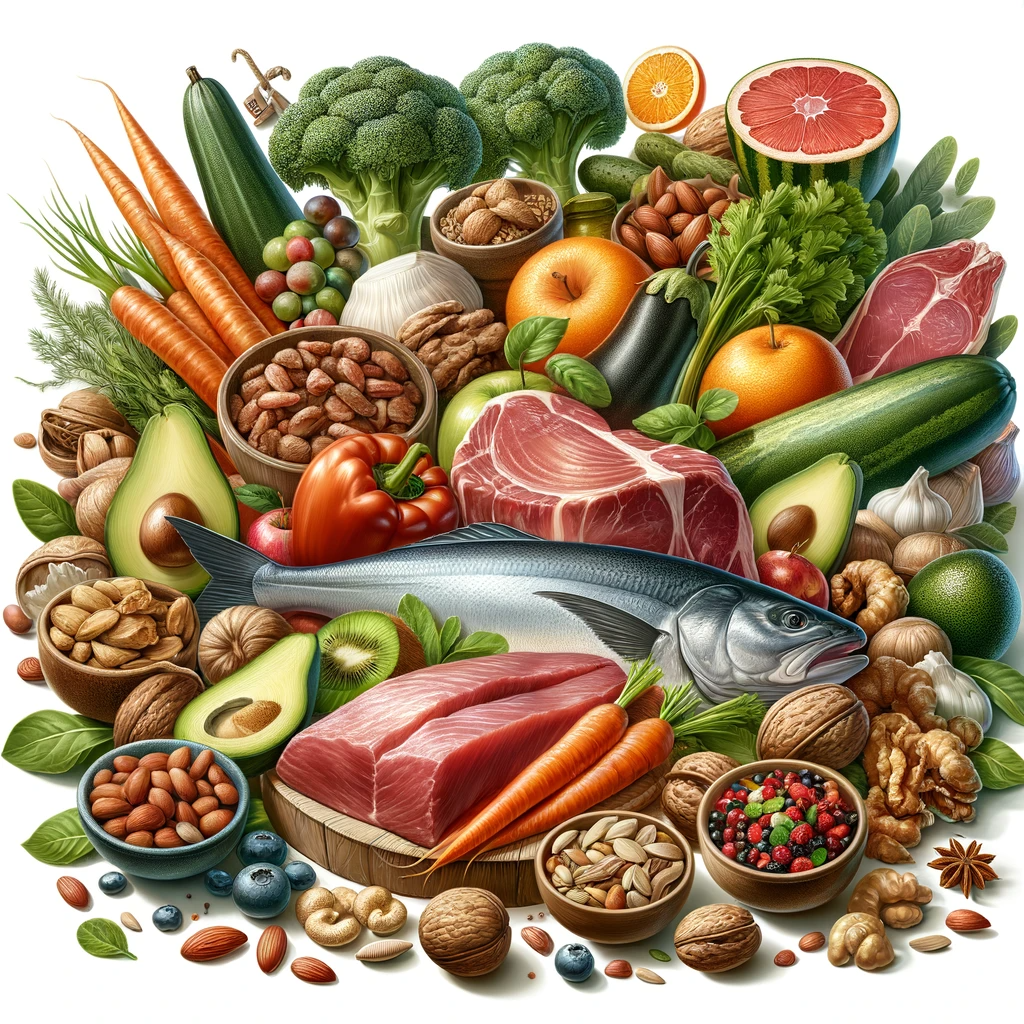Are you trying to cut down on your sugar intake but finding it challenging to identify hidden sugars in processed foods? Don’t worry, you’re not alone. In a recent study conducted by the Journal of the American Medical Association, researchers found that the average American consumes around 17 teaspoons of added sugars per day, primarily from processed foods. Another study from the British Advertising Standards Authority revealed that nearly 50% of children’s food products contain hidden sugars. Understanding how to spot these sneaky sugars is essential for maintaining a healthy diet. In this article, we will provide you with practical tips and tricks to easily identify and avoid hidden sugars in the foods you consume. So, let’s get started on your journey to a healthier lifestyle!
Click Here for Proven Fat-Burning Strategies!
Understanding Added Sugars
Differentiating between natural sugars and added sugars
When it comes to sugars, not all are created equal. Natural sugars, such as those found in fruits and dairy products, come packaged with essential nutrients like fiber and vitamins. Added sugars, on the other hand, are sugars that have been added to foods during processing or preparation. These added sugars provide empty calories without any nutritional value. It’s important to be able to distinguish between the two and make informed choices about the foods you consume.
The dangers of consuming excessive added sugars
Consuming excessive amounts of added sugars can have negative effects on your health. Numerous studies have linked high intake of added sugars to various health issues, including obesity, cardiovascular disease, type 2 diabetes, and tooth decay. Excess sugar consumption can lead to weight gain, as sugars are rapidly absorbed into the bloodstream, causing an increase in blood sugar levels and triggering the release of insulin. Regularly consuming large amounts of added sugars can lead to insulin resistance, which is a precursor to developing type 2 diabetes.
The importance of identifying hidden sugars in processed foods
Processed foods are notorious for containing high amounts of hidden sugars. These sugars are cleverly disguised under different names on food labels, making it challenging to decipher their true quantity. Being able to identify hidden sugars in processed foods is essential if you want to maintain a healthy diet and reduce your intake of added sugars. It is crucial to read food labels carefully and understand the different names for added sugars to make informed choices about the foods you consume.
Reading Food Labels
Identifying the different names for added sugars
Food manufacturers use various names for added sugars, which can be confusing for consumers trying to make healthy choices. Some common names for added sugars include sucrose, high fructose corn syrup, cane sugar, brown sugar, maltose, and dextrose. It’s important to familiarize yourself with these terms and read ingredient labels carefully to spot the presence of added sugars in processed foods. By being aware of the different names for added sugars, you can make more informed decisions about the foods you purchase.
Calculating the sugar content per serving
When reading food labels, it’s important to pay attention to the sugar content per serving. The sugar content is typically listed in grams or teaspoons. It’s helpful to have a general understanding of how much sugar is considered high or low in a single serving. According to the American Heart Association, men should consume no more than 36 grams (9 teaspoons) of added sugars per day, and women should consume no more than 25 grams (6 teaspoons) per day. By calculating the sugar content per serving, you can track your sugar intake and make healthier choices.
Understanding the order of ingredients
The order in which ingredients are listed on a food label can provide insight into the quantity of added sugars. Ingredients are listed in descending order by weight, meaning the ingredient present in the greatest quantity is listed first. If a sugary ingredient, such as “high fructose corn syrup,” is one of the first few ingredients, it indicates a high sugar content in the product. On the other hand, if sugar-related ingredients are at the end of the list, it suggests a lower sugar content. Understanding the order of ingredients can help you make more informed decisions about the processed foods you choose to consume.

Unlock Your Path to a Healthier You!
Analyzing Carbohydrate Content
Recognizing the different types of carbohydrates
Carbohydrates are a macronutrient found in various foods, including sugars, fibers, and starches. When analyzing carbohydrate content, it’s important to recognize the different types of carbohydrates present. Sugars, both natural and added, are simple carbohydrates, while fibers and starches are complex carbohydrates. Understanding the distinction between these carbohydrates is crucial because added sugars should be minimized, while fibers and whole grains should be emphasized in a healthy diet.
Differentiating between complex and simple carbohydrates
Complex carbohydrates, like those found in whole grains and vegetables, contain longer chains of sugar molecules that take longer to break down in the body. Simple carbohydrates, such as those found in sweets and sugary drinks, are composed of shorter chains of sugar molecules that are quickly metabolized, leading to rapid spikes in blood sugar levels. By differentiating between complex and simple carbohydrates, you can make wiser decisions about the types of carbohydrates you consume and minimize your intake of added sugars.
Determining the sugar content from the total carbohydrate value
When reading food labels, the total carbohydrate value includes both sugars and other carbohydrates, such as fibers and starches. To determine the sugar content from the total carbohydrate value, you need to review the breakdown of carbohydrates listed on the label. Look for the “sugars” category within the total carbohydrate value. This will tell you specifically how much sugar is present in each serving. By understanding the sugar content in relation to the total carbohydrate value, you can make more informed choices about the products you consume.
Spotting Sneaky Sugar Synonyms
Identifying alternative names for sugar on ingredient lists
Food manufacturers often use alternative names for sugar to mask its presence in processed foods. Some common synonyms for sugar include maltose, fructose, dextrose, glucose, lactose, and sucrose. By familiarizing yourself with these terms, you can spot hidden sugars on ingredient lists and make more informed decisions about the foods you choose to consume.
Understanding the use of terms like maltose, dextrose, and sucrose
Terms like maltose, dextrose, and sucrose are specific types of sugars that are commonly used as sweeteners in processed foods. Maltose is derived from malted grains and is often used in cereals and baked goods. Dextrose is a form of glucose, which is a simple sugar found in many foods. Sucrose, also known as table sugar, is commonly used to sweeten a wide range of processed foods and beverages. Understanding the use of these terms can help you identify hidden sugars in the foods you consume.
Being aware of hidden sugars in disguise
Hidden sugars can be disguised under various names, making it difficult to identify them on food labels. They can be present in condiments, sauces, dressings, and even savory foods like bread or canned soups. Being aware of hidden sugars in disguise allows you to make more informed choices about the foods you consume. By reading labels carefully and being mindful of the various names used for added sugars, you can avoid hidden sources of excess sugar in your diet.

Checking for Sugar Alcohols
Understanding the purpose of sugar alcohols in processed foods
Sugar alcohols are sweeteners commonly used in sugar-free or reduced-sugar products. They provide a similar sweet taste to sugar but contain fewer calories. Sugar alcohols can be found in various processed foods, including sugar-free candies, baked goods, and chewing gums. Understanding the purpose of sugar alcohols in processed foods allows you to make informed decisions about their consumption and potential impact on your health.
Recognizing common types of sugar alcohols
Common types of sugar alcohols include xylitol, sorbitol, erythritol, and mannitol. These sugar alcohols are derived from plant sources and provide a sweet taste without raising blood sugar levels as rapidly as regular sugar. However, excessive consumption of sugar alcohols can have a laxative effect and lead to digestive issues, especially in individuals with sensitivity to these compounds. By recognizing common types of sugar alcohols, you can be aware of their presence in processed foods and moderating your intake accordingly.
Determining the impact of sugar alcohols on blood sugar levels
While sugar alcohols do not cause the same rapid rise in blood sugar levels as regular sugar, it’s important to understand that they still have a glycemic impact. Different sugar alcohols have varying glycemic indexes, which indicates the extent to which they raise blood sugar levels. Individuals with diabetes or those following a low-carbohydrate diet should be mindful of the glycemic impact of sugar alcohols when consuming them. By determining the impact of sugar alcohols on blood sugar levels, you can make informed decisions about your dietary choices.
Decoding Food Claims and Marketing Terms
Recognizing misleading claims such as ‘sugar-free’ or ‘no added sugars’
Food manufacturers often use misleading claims on product packaging to attract health-conscious consumers. Terms like “sugar-free” or “no added sugars” can be deceptive, as they do not necessarily mean that the product is free of sweetness. These claims often indicate that alternative sweeteners, such as artificial sweeteners or sugar alcohols, have been used instead of traditional sugar. It’s important to be critical of such claims and examine the ingredient list and nutritional information to make truly informed choices about the foods you purchase.
Understanding the difference between natural and artificial sweeteners
Natural sweeteners, such as honey or maple syrup, are derived from natural sources and contain more nutrients than table sugar. Artificial sweeteners, on the other hand, are synthetic compounds that provide sweetness without the added calories. Understanding the difference between natural and artificial sweeteners allows you to make informed decisions about the types of sweeteners you choose to include in your diet. It’s important to note that while artificial sweeteners may offer calorie savings, they can still trigger cravings for sweet foods and beverages.
Being skeptical of ‘healthy’ marketing claims
Food packaging often includes marketing claims that suggest a product is healthy or nutritious. However, it’s essential to approach these claims with skepticism and examine the ingredient list and nutritional information. Terms like “all-natural,” “organic,” or “immune-boosting” can be misleading if the product also contains high amounts of added sugars. By being skeptical of ‘healthy’ marketing claims, you can make more informed choices about the foods you consume and prioritize your overall health.

Considering Serving Sizes
Being mindful of the actual serving size listed on the package
Food labels specify the serving size, which may differ from the portion size consumed. It’s important to be mindful of the actual serving size listed on the package to accurately assess the sugar content. The amount of sugar listed on the label corresponds to a single serving, and consuming more than the specified portion can lead to higher sugar intake. By paying attention to the serving size, you can better manage your sugar consumption and make informed choices about portion control.
Understanding how sugar content can be deceptive based on serving sizes
Food manufacturers sometimes manipulate serving sizes on packages to make the sugar content appear lower. For example, a small snack pack may list a serving size as half of the package, leading consumers to believe they are consuming fewer sugars than they actually are. Understanding how sugar content can be deceptive based on serving sizes enables you to critically evaluate the actual amount of sugar you’re consuming and make more informed choices about portion control.
Multiplying the sugar content for a more accurate representation
To gain a more accurate representation of the sugar content in a product, you can multiply the sugar content listed on the label by the number of servings you consume. This calculation helps you understand the total sugar intake from a particular food or beverage. It’s important to be mindful of portion sizes and adjust the sugar content accordingly. By multiplying the sugar content for a more accurate representation, you can make more informed choices about the foods you consume and maintain a balanced sugar intake.
Analyzing Nutritional Information
Examining the grams of sugar per serving
When analyzing nutritional information, pay close attention to the grams of sugar per serving. This information provides a specific measurement of the total amount of sugar contained in a single serving of the product. By examining the grams of sugar per serving, you can easily compare different products and make educated decisions about the amount of sugar you consume on a daily basis.
Comparing the sugar content to other nutrients
In addition to examining the grams of sugar per serving, it’s important to compare the sugar content to other nutrients listed on the nutritional information panel. Consider the overall nutritional value of the product and evaluate whether the sugar content is excessive in relation to other nutrients. A product that contains high amounts of sugar but lacks essential vitamins and minerals may not be a wise choice. By comparing the sugar content to other nutrients, you can prioritize foods that offer a better balance of nutritional value.
Understanding the recommended daily limits for sugar intake
To make informed choices about sugar consumption, it’s important to understand the recommended daily limits. The American Heart Association recommends limiting added sugar intake to no more than 6 teaspoons (25 grams) for women and 9 teaspoons (36 grams) for men. By referring to these guidelines, you can evaluate the sugar content of products and make educated decisions about your overall sugar intake. It’s crucial to remember that these limits apply specifically to added sugars, and natural sugars from fruits and dairy can still be enjoyed in moderation.

Avoiding Hidden Sugars in Common Foods
Identifying hidden sugars in breakfast cereals
Breakfast cereals are often considered a healthy choice, but they can be hidden sources of added sugars. Many cereals marketed towards children contain high amounts of added sugars. Check the nutrition labels of breakfast cereals and be mindful of terms like “honey-flavored,” “maple,” or “chocolate” as they often indicate added sugars. Opt for whole-grain cereals with minimal added sugars or choose to sweeten your cereal with fresh fruits instead.
Spotting sugary additives in packaged drinks
Packaged drinks, such as sodas, fruit juices, and energy drinks, are notorious for their high sugar content. Even seemingly healthy options like bottled smoothies or iced teas can contain hidden sugars. Carefully read the labels and avoid products that list sugar or its alternative names as one of the main ingredients. Instead, opt for water, unsweetened tea, or create your own fruit-infused waters to quench your thirst without added sugars.
Being cautious of condiments and sauces
Condiments and sauces, such as ketchup, salad dressings, and barbecue sauce, can contain significant amounts of hidden sugars. These items are typically used in small amounts, but their sugar content can quickly add up if consumed regularly. Read the labels of condiments and sauces and choose options with lower sugar content or consider making your own from scratch using healthier alternatives like herbs, spices, and vinegar.
Making Informed Choices
Opting for whole, unprocessed foods
One of the best ways to avoid hidden sugars is to opt for whole, unprocessed foods. Fresh fruits, vegetables, whole grains, and lean proteins offer an array of nutrients without the added sugars found in processed foods. By prioritizing whole foods, you not only reduce your sugar intake but also support your overall health and well-being.
Cooking meals from scratch to have control over ingredients
Cooking meals from scratch gives you full control over the ingredients you use and allows you to create healthier alternatives to processed foods. By preparing your meals at home, you can choose natural sweeteners like honey or maple syrup in moderation, rather than relying on added sugars. Experiment with new recipes, embrace fresh ingredients, and enjoy the freedom of creating meals that align with your health goals.
Seeking healthier alternatives and substitutes
There is a wide range of healthier alternatives and substitutes available for foods and beverages that contain hidden sugars. Instead of reaching for sugary snacks, choose fresh fruits, nuts, or homemade energy bars. Try unsweetened versions of yogurt or replace sugary drinks with infused water or herbal tea. By seeking out healthier alternatives and substitutes, you can satisfy your cravings while still reducing your sugar intake.
In conclusion, understanding added sugars, reading food labels, analyzing carbohydrate content, spotting sneaky sugar synonyms, checking for sugar alcohols, decoding food claims, considering serving sizes, analyzing nutritional information, avoiding hidden sugars in common foods, and making informed choices are all crucial aspects of managing your sugar consumption. By familiarizing yourself with the various terms associated with added sugars, carefully examining food labels, and prioritizing whole, unprocessed foods, you can make informed decisions about the foods you consume and work towards maintaining a balanced and healthy diet.

